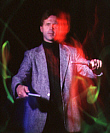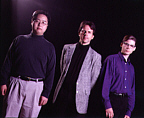
News Release
|
Office of News and Information |
Johns Hopkins University 3003 N. Charles Street, Suite 100 Baltimore, Maryland 21218-3843 Phone: (410) 516-7160 Fax (410) 516-5251
November 27, 1999 |
FOR IMMEDIATE RELEASE CONTACT: Anne Garside, Peabody Conservatory, 410-659-8163 Jan Wootten Rubenstein Associates Inc., for Times Square, 212-843-8032 |
"Virtual" Orchestra, Anthem from Peabody
On New Year's Eve, Times Square 2000, the celebration at New York's Times Square, will feature a Virtual Orchestra from Peabody performing "Ascent of Time"
New York's Times Square will welcome the New Year with the world premiere of "Ascent of Time," by Peabody composer Charles Byungkyu Kim, performed by Lightning Virtuoso Forrest Tobey, with a Virtual Orchestra developed at Peabody.
Kim, 27, and Tobey, 44, are double-degree graduates of the Peabody Institute of The Johns Hopkins University. The Peabody Institute, established in 1857, is America's first conservatory of music. Kim also holds a computer science degree from the University's Whiting School of Engineering. Both Kim and Tobey are Artists-in-Residence at the Peabody Computer Music Department.

|
|
Tobey (center) is collaborating with Charles Kim (left) and David
Wetzel on Times Square 2000. Photos by Craig Terkowitz Courtesy Johns Hopkins Magazine |
Charles Byungkyu Kim's four-minute "Ascent of Time" will be heard just before the one-minute countdown to midnight when the famous "Ball" is lowered.
The heroic sounds of "Ascent of Time" are a blend of old and new. The "old" is represented by organ and symphony orchestra. The "new" brings in the electronic timbres and textures of the Virtual Orchestra. The organ and orchestra parts will be pre-recorded at Peabody. The additional part for the Virtual Orchestra will be performed live by Forrest Tobey at Times Square.
Tobey will stand alone in Times Square armed only with a pair of infrared light-emitting wands. He will reach the wands into the open air surrounding him. Each movement will activate and play non-corporeal instruments through sensors that will generate sounds from a computer.
 |
| The computer music group takes
a break from working almost round the clock to meet deadlines for
the Times Square celebration. Back row, from the left: Geoffrey
Wright, Forrest Tobey, David Wetzel, Charles Kim. Front row: Jer
Walter, Gustavo de Andrede, Larry Schugam and Sumi Yun. Photo courtesy The Gazette |
Tobey's performance will combine the gestural expressiveness of a symphony conductor with the physical excitement and exertion of a percussionist and the subtle movements of a Tai chi practitioner. Tobey treats the computer as an expressive instrument that responds to the subtleties of his physical movements, just as if he were playing a violin or a piano.
Tobey has created a host of virtual instruments for his Virtual Orchestra. Downward strikes may conjure up a marimba. Sideway flourishes may call forth the sound of a tree of hanging bells. Still other spatial gestures play elaborate melodies on hybrid instruments of breath and electricity.
The location, direction, and speed of the batons through space are tracked by an infrared receiver and translated into digital information sent to a computer. The light-emitting batons are part of a unique musical instrument known as the Lightning, developed by Don Buchla and Associates of Berkeley, California. Buchla has custom redesigned his device to withstand the intense signal saturation of Times Square.
Tobey's Virtual Orchestra will be heard in Times Square at several points during the 24-hour celebrations, performing other compositions/arrangements by Charles Kim.
The Times Square celebration plans to travel by satellite television round the globe as the new millennium dawns in each of the world's 24 time zones. As the first zones to celebrate the New Year include Pacific islands like Fiji, New Guinea and New Zealand, the Virtual Orchestra begins with aborigine-type instruments evoking drums and hollow logs and moves through an ethnic spectrum to Debussy-like sounds of Western classical music.
The Times Square Business Improvement District requested that the Virtual Orchestra also play something uniquely American. Charles Byungkyu Kim has therefore arranged Aaron Copland's "Fanfare for the Common Man" for the Virtual Orchestra. The Aaron Copland Centenary is being celebrated in the year 2000. By arrangement with the Aaron Copland Foundation, Copland's most famous work of the old century will be conducted live on virtual instruments at the beginning of the new.
Enormous technological sophistication and logistical support are required to perform live at Times Square on New Year's Eve, with all the potential hazards of weather, massed crowds and electronic interference. Making the Virtual Orchestra work on an outdoor stage in an arena of skyscraper buildings with the necessary split-second timing "is the computer music equivalent," says one member of the Peabody production team, "of Evil Knievel jumping the Snake River Canyon."
The Times Square performances by the Peabody musicians are under the artistic direction of Dr. Geoffrey Wright, Director of Peabody's Computer Music Department and of its Technology Transfer Office.
The Peabody production team will take up residence at Times Square during the night of Dec. 30 and work around the clock with another Baltimore group -- Maryland Sound Corp., led by its president, Robert Goldstein. Maryland Sound has been contracted separately by BID to play a critical role throughout the 24-hour celebration. The company will provide a 16-channel sound system and 18 speaker stacks from 43rd to 47th Streets in Times Square.
|
Key People
Charles Byungkyu Kim, Composer/Arranger
Dr. Forrest Tobey, Lightning Virtuoso/Virtual
Orchestra
Dr. Geoffrey Wright, Artistic Director for Peabody
Performances at Times Square
Donald Sutherland, Organ Soloist for "Anthem for the
Millennium: Ascent of Time"
Peabody Production/Recording Team for Times Square
2000
Peabody Artists/Performers for Times Square 2000
About the Peabody Institute of
Dr. Robert Sirota, Director
About the Peabody
Dr. Geoffrey Wright, Director
About the Peabody
Dr. Geoffrey Wright, Director |
|
Johns Hopkins University news releases can be found on the
World Wide Web at
http://www.jhu.edu/news_info/news/ Information on automatic e-mail delivery of science and medical news releases is available at the same address.
|
 Go to
Headlines@HopkinsHome Page
Go to
Headlines@HopkinsHome Page
